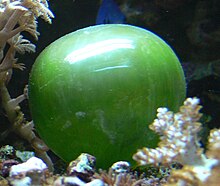Valonia ventricosa
| Valonia ventricosa | |
|---|---|

| |
| Scientific classification | |
| Kingdom: | |
| Phylum: | |
| Order: | |
| Family: | |
| Genus: | Valonia
|
| Species: | V. ventricosa
|
| Binomial name | |
| Valonia ventricosa J.Agardh 1887.[1]
| |
Valonia ventricosa, also known as "bubble algae" and "sailors’ eyeballs",[2] is a species of algae found in oceans throughout the world in tropical and subtropical regions. It is one of the largest single-celled organisms.[2][3] However, although genuinely a single cell, it has more than one nucleus.[4]
Characteristics[change | change source]
Environment[change | change source]
Valonia ventricosa usually grow alone, but sometimes they grow in groups. They appear in the littoral zones and continental shelf of tropical and subtropical areas, like the Caribbean, north to Florida, south to Brazil, and in the Indo-Pacific.[2] Overall, they inhabit most oceans in the world,[5] often living in broken coral.[6] The deepest water it lives in is about 80 metres (260 ft).
Physiology and reproduction[change | change source]
The single-cell organism has a spherical to ovoid (egg-like) shape. The colour varies from grass green to dark green (though in deep dark water they may appear to be silver, teal, or even blackish).[2] This is determined by the number of chloroplasts of the specimen.[6] The surface of the cell shines like glass. The body is a thin-walled, tough, single cell with more than one nucleus. The diameter is usually from 1 to 4 centimetres (0.39 to 1.57 in) although it may get to 5.1 centimetres (2.0 in) in rare cases. The "bubble" alga is attached to the bottom by fibres: "... anchored to a substrate by minute hair-like appendages called rhizoids that create a surprisingly strong hold".[2]
Reproduction occurs by cell division, where the multinucleic mother cell makes daughter cells, which become separate from the mother cell.
Studies[change | change source]
Because its cells are so large, Valonia ventricosa has been used to study the permeability of cell membranes.[2][7]<[8] In studying the cellulose lattice in the cell wall, Valonia ventricosa has undergone extensive X-ray analytical procedures.[9] It has also been studied for its electrical properties, due to its unusually high electrical potential relative to the seawater that surrounds it.[7]
References[change | change source]
- ↑ "Valonia ventricosa. J. Agardh". ITIS. Retrieved 27 August 2010.
- ↑ 2.0 2.1 2.2 2.3 2.4 2.5 Bauer, Becky (October 2008). "Gazing Balls in the Sea". All at Sea. Retrieved 26 September 2013.
- ↑ John Wesley Tunnell, Ernesto A. Chávez, Kim Withers (2007). Coral reefs of the southern Gulf of Mexico. Texas A&M University Press. p. 91. ISBN 978-1-58544-617-9.
{{cite book}}: CS1 maint: multiple names: authors list (link) - ↑ The references use the word "multinucleate", without specifying number.
- ↑ Overview occurrence, Valonia ventricosa, GBIF, accessed 27 August 2010
- ↑ 6.0 6.1 Lee, Robert Edward (2008). "Siphonoclades". Phycology. Cambridge University Press. p. 189. ISBN 978-0-521-68277-0. Retrieved 27 August 2010.
- ↑ 7.0 7.1 Thellier, M. (1977). Échanges ioniques transmembranaires chez les végétaux. Publication Univ Rouen Havre. p. 341. ISBN 978-2-222-02021-9.
- ↑ Gutknecht, John (1967). "Membranes of Valonia ventricosa: Apparent Absence of Water-Filled Pores". Science. 158 (3802). Science Magazine: 787–788. Bibcode:1967Sci...158..787G. doi:10.1126/science.158.3802.787. PMID 6048117. S2CID 206566223. Retrieved 10 September 2014.
- ↑ Astbury, W.T; Marwick, T. C.; Bernal, J. D. (1932). "X-Ray analysis of the structure of the wall of Valonia ventricosa. I". Proceedings of the Royal Society of London. Series B. 109 (764): 443. Bibcode:1932RSPSB.109..443A. doi:10.1098/rspb.1932.0005. JSTOR 81568.
Other websites[change | change source]
- "Ventricaria: J.L.Olsen & J.A.West, 1988: 104". algaebase.org.
